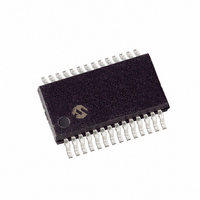PIC18F25J10-I/SS Microchip Technology, PIC18F25J10-I/SS Datasheet - Page 149

PIC18F25J10-I/SS
Manufacturer Part Number
PIC18F25J10-I/SS
Description
IC PIC MCU FLASH 16KX16 28SSOP
Manufacturer
Microchip Technology
Series
PIC® 18Fr
Datasheets
1.PIC16F616T-ISL.pdf
(8 pages)
2.PIC18F24J10-ISO.pdf
(368 pages)
3.PIC18F24J10-ISO.pdf
(6 pages)
4.PIC18F24J10-ISO.pdf
(6 pages)
5.PIC18F24J10-ISO.pdf
(12 pages)
6.PIC18LF24J10-ISS.pdf
(32 pages)
7.PIC18F45J10-IPT.pdf
(362 pages)
Specifications of PIC18F25J10-I/SS
Core Size
8-Bit
Program Memory Size
32KB (16K x 16)
Peripherals
Brown-out Detect/Reset, POR, PWM, WDT
Core Processor
PIC
Speed
40MHz
Connectivity
I²C, SPI, UART/USART
Number Of I /o
21
Program Memory Type
FLASH
Ram Size
1K x 8
Voltage - Supply (vcc/vdd)
2.7 V ~ 3.6 V
Data Converters
A/D 10x10b
Oscillator Type
Internal
Operating Temperature
-40°C ~ 85°C
Package / Case
28-SSOP
Controller Family/series
PIC18
No. Of I/o's
21
Ram Memory Size
1KB
Cpu Speed
40MHz
No. Of Timers
3
Processor Series
PIC18F
Core
PIC
Data Bus Width
8 bit
Data Ram Size
1 KB
Interface Type
SPIC, I2C, EUSART
Maximum Clock Frequency
40 MHz
Number Of Programmable I/os
21
Number Of Timers
3
Maximum Operating Temperature
+ 85 C
Mounting Style
SMD/SMT
3rd Party Development Tools
52715-96, 52716-328, 52717-734, 52712-325, EWPIC18
Development Tools By Supplier
PG164130, DV164035, DV244005, DV164005, PG164120, DM183022, DM183032, DV164136
Minimum Operating Temperature
- 40 C
On-chip Adc
10 bit, 10 Channel
Package
28SSOP
Device Core
PIC
Family Name
PIC18
Maximum Speed
40 MHz
Operating Supply Voltage
5 V
Lead Free Status / RoHS Status
Lead free / RoHS Compliant
For Use With
AC162074 - HEADER INTRFC MPLAB ICD2 44TQFPMA180011 - MODULE PLUG-IN 18F25J10 28SOICAC162067 - HEADER INTRFC MPLAB ICD2 40/28PAC164331 - MODULE SKT FOR 28SSOP 18F45J10XLT28SS-1 - SOCKET TRANSITION ICE 28SSOP
Eeprom Size
-
Lead Free Status / Rohs Status
Details
Available stocks
Company
Part Number
Manufacturer
Quantity
Price
Part Number:
PIC18F25J10-I/SS
Manufacturer:
MICROCHIP/微芯
Quantity:
20 000
- PIC16F616T-ISL PDF datasheet
- PIC18F24J10-ISO PDF datasheet #2
- PIC18F24J10-ISO PDF datasheet #3
- PIC18F24J10-ISO PDF datasheet #4
- PIC18F24J10-ISO PDF datasheet #5
- PIC18LF24J10-ISS PDF datasheet #6
- PIC18F45J10-IPT PDF datasheet #7
- Current page: 149 of 362
- Download datasheet (6Mb)
REGISTER 15-2:
© 2008 Microchip Technology Inc.
bit 7
Legend:
R = Readable bit
-n = Value at POR
bit 7
bit 6
bit 5
bit 4
bit 3-0
Note 1:
WCOL
R/W-0
2:
3:
In Master mode, the overflow bit is not set since each new reception (and transmission) is initiated by
writing to the SSPxBUF register.
When enabled, these pins must be properly configured as input or output.
Bit combinations not specifically listed here are either reserved or implemented in I
WCOL: Write Collision Detect bit
1 = The SSPxBUF register is written while it is still transmitting the previous word (must be cleared in
0 = No collision
SSPOV: Receive Overflow Indicator bit
SPI Slave mode:
1 = A new byte is received while the SSPxBUF register is still holding the previous data. In case of
0 = No overflow
SSPEN: Master Synchronous Serial Port Enable bit
1 = Enables serial port and configures SCKx, SDOx, SDIx and SSx as serial port pins
0 = Disables serial port and configures these pins as I/O port pins
CKP: Clock Polarity Select bit
1 = Idle state for clock is a high level
0 = Idle state for clock is a low level
SSPM3:SSPM0: Master Synchronous Serial Port Mode Select bits
0101 = SPI Slave mode, clock = SCKx pin, SSx pin control disabled, SSx can be used as I/O pin
0100 = SPI Slave mode, clock = SCKx pin, SSx pin control enabled
0011 = SPI Master mode, clock = TMR2 output/2
0010 = SPI Master mode, clock = F
0001 = SPI Master mode, clock = F
0000 = SPI Master mode, clock = F
SSPOV
R/W-0
software)
overflow, the data in SSPxSR is lost. Overflow can only occur in Slave mode. The user must read
the SSPxBUF, even if only transmitting data, to avoid setting overflow (must be cleared in
software).
SSPxCON1: MSSPx CONTROL REGISTER 1 (SPI MODE)
(1)
W = Writable bit
‘1’ = Bit is set
SSPEN
R/W-0
(2)
R/W-0
CKP
OSC
OSC
OSC
(1)
/64
/16
/4
U = Unimplemented bit, read as ‘0’
‘0’ = Bit is cleared
SSPM3
PIC18F45J10 FAMILY
R/W-0
(2)
(3)
SSPM2
R/W-0
(3)
(3)
x = Bit is unknown
SSPM1
R/W-0
2
C™ mode only.
(3)
DS39682D-page 147
SSPM0
R/W-0
bit 0
(3)
Related parts for PIC18F25J10-I/SS
Image
Part Number
Description
Manufacturer
Datasheet
Request
R

Part Number:
Description:
Manufacturer:
Microchip Technology Inc.
Datasheet:

Part Number:
Description:
Manufacturer:
Microchip Technology Inc.
Datasheet:

Part Number:
Description:
Manufacturer:
Microchip Technology Inc.
Datasheet:

Part Number:
Description:
Manufacturer:
Microchip Technology Inc.
Datasheet:

Part Number:
Description:
Manufacturer:
Microchip Technology Inc.
Datasheet:

Part Number:
Description:
Manufacturer:
Microchip Technology Inc.
Datasheet:

Part Number:
Description:
Manufacturer:
Microchip Technology Inc.
Datasheet:

Part Number:
Description:
Manufacturer:
Microchip Technology Inc.
Datasheet:











